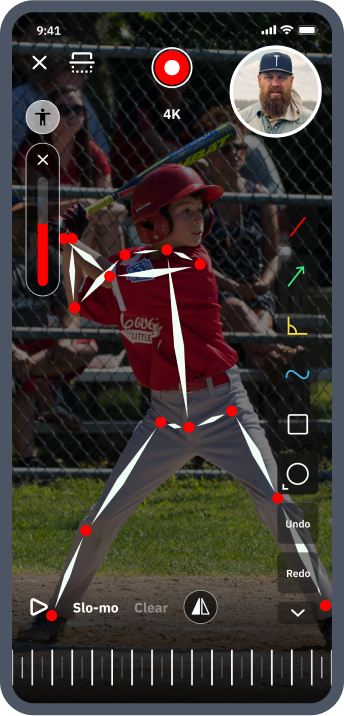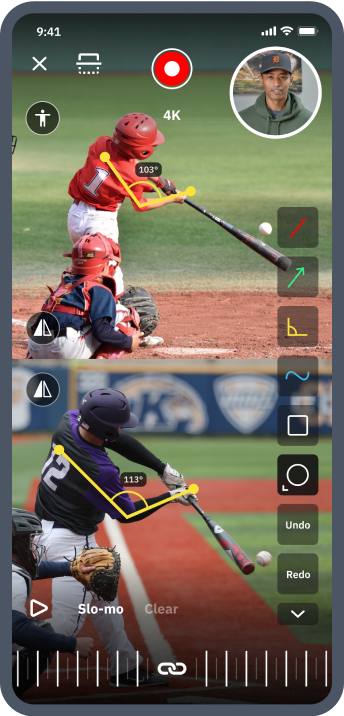Are Weighted Balls Good for Pitchers? | What Baseball Biometrics Tells Us

Weighted baseballs are a controversial subject.
When they were first developed, coaches avoided using them at all costs. Today, entire velocity development programs revolve around weighted baseballs.
Some coaches and trainers claim that weighted balls are the best way to improve velocity in young pitchers. Others think they increase the risk of injury too much to be worth it.
How are young pitchers and their parents supposed to react to these opposing claims – should you use a weighted ball training program or not?
In this article, we’ll go over several details related to weighted baseballs to give you the fullest picture possible:
- A brief history of weighted ball drills and velocity development programs
- Why velocity is so important
- Whether weighted balls increase velocity (and other effects)
- What a biometric analysis of weighted ball training demonstrates
- If you should do a weighted ball program
The History of Weighted Ball Drills and Velocity Development
Weighted baseballs have been around for a few decades. But when organizations like Driveline Baseball and the Texas Baseball Ranch first started pushing their use, most coaches wanted nothing to do with them.
As Kyle Boddy points out in a blog post for Driveline, at that time coaches weren’t doing anything to help pitchers develop velocity.
As a result of career coaches’ inherent skepticism toward new methods, many weighted ball proponents had to work hard just to convince fellow experts that such training even worked in the first place.
Their persistent educational and evangelizing efforts certainly paid off.
These days, many coaches and players think using weighted balls is a necessity for high school pitchers and even younger athletes.

The Prevalence of Velocity Enhancement Programs Online
Both Boddy and weighted baseball training authority Mike Reinold point out how prevalent generic online programs for weighted baseball training are – and consider them part of the problem.
Reinold and his colleague Lenny Macrina have conducted research on weighted baseball use among young pitchers, with the help of Dr. Glenn Fleisig and Dr. James Andrews from the American Sports Medicine Institute.
Their findings have shed light on weighted baseball use, including how effective they are, their benefits, and their disadvantages.
In a post for Elite Baseball Performance, Reinold notes how pitch velocity increased in the MLB between 2008 and 2017, and how this emphasis on speed has, in turn, sparked the creation of velocity enhancement programs marketed to young pitchers online.
Reinold cautions pitchers to be wary of the programs that stress the use of overweighted and underweighted baseballs without backing their programs up with real peer-reviewed research.
Reinold and his colleagues initiated several research projects related to weighted balls, partially in response to all these online programs popping up.
They knew that weighted ball training worked, but they didn’t know why, exactly.
Reinold and his team wanted to test the efficacy of weighted ball training on velocity and find out if it was also related to the rising number of Tommy John surgeries among high school and collegiate pitchers.
Hint: they suspected that it was.

Do Weighted Ball Drills Actually Increase Velocity?
Studies into the subject have shown that yes, weighted baseball training increases a pitcher’s average velocity.
But the same studies also show that those increases might not be for the safest reasons.
The reasons weighted balls work for pitchers is still not totally clear, but some researchers have been trying to get to the bottom of it in the last few years.
Below, we’ll dive deeper into what they’re saying.
But first, does velocity even matter in the first place?
Does Velocity Matter for Young Pitchers?
The short answer is yes. Velocity matters at all levels.
The very nature of the game requires ballplayers both on the mound and on defense to at times hurl baseballs in live-game situations using the maximum physical force that their bodies can muster.
Baseball games are competitions after all, and the need to throw hard is simply a by-product of interacting within this competitive landscape.
Whether it’s a youth pitcher giving everything they’ve got to find success against a rival team, a shortstop trying to make the put out to first base and beat a speedster, or an outfielder crow-hopping from deep left-center to prevent a runner from scoring, the game itself demands players throw max effort sometimes regardless of age.

When to Start Weighted Ball Training?
But just because velocity is an obvious advantage for competitive success at all levels, doesn’t mean we recommend weighted ball training for youth ballplayers.
And once this very table steaks requirement is met, at least a year of total body strength training and arm care basics, along with a professional physical assessment of current mobility and physical development, should also precede any weighted ball consideration.
Unlock your ballplayer’s full potential
Find the perfect vetted coach to build a solid foundation or take your player's skills to new heights.
Download the free app

Does Pitching Velocity Matter for High School Players?
Pitchers who are high school aged and above are under more pressure than ever to increase their velocity if they want serious looks from college recruiters or professional scouts.
College programs say they care about more than just velocity, but all acknowledge that having decent speed gives a pitcher more room for error.
Firstly, the modern game has fully adopted a trust in and partial reliance on performance metrics.
This fact alone has caused the pro and collegiate scout landscape to change significantly over the past ten years.
Performance metrics, like pitching velo and spin rate, have now become table stakes for getting on any scout’s consideration radar.
The pandemic further exacerbated this trend because college recruiters and pro scouts could not travel in-person to see athletes perform in games and gather more subjective gut opinions or pick up on player intangibles.
Hence, they relied even more heavily on objective measurements to help guide their initial interest level.
Even before the pandemic, though, baseball showcases’ high-quality metrics and game footage coincided with smaller and smaller travel expense budgets for college recruiters.
Together, these two factors led to fewer overall in-person looks at local high school or travel ball games.
And professional scouts that we’ve spoken to have shared privately that they rarely ever move forward with pitching prospects that their organization won’t consider a fit for the modern high-velocity MLB game that we mentioned earlier.
Many scouts are incentivized in various ways by management to almost exclusively consider ballplayers who fit standardized right or left-handed velocity, pitch movement, and body size molds.
This leads to pitchers who are lower on things like velo and spin rate metrics, but consistently successful in real high school or college games by employing great location control and being A+ competitors, often being overlooked.
Many young athletes have turned to these velocity and weighted ball programs, wanting to give themselves a chance with college recruiters or pro scouts, and their choice is frankly understandable.

The Science Behind Weighted Ball Training
Reinold and his colleagues conducted a study in 2010 that looked at the biomechanical and physical impacts throwing weighted baseballs have on the shoulder and elbow.
Their six-week study was primarily a fact-finding mission. They weren’t as interested in whether weighted baseballs increase velocity or not – previous studies had already addressed that.
Instead, they wanted to gather data about what throwing weighted baseballs does to the shoulder and elbow, to draw any conclusions about injuries, and the effectiveness of weighted balls.
Their six-week study had five major takeaways:
- Pitchers using weighted baseballs increased their velocity, but so did pitchers not using weighted baseballs.
- The group using weighted baseballs increased their shoulder external rotation, which has been linked to pitching injuries.
- The non-weighted baseball group developed more rotator cuff strength than the weighted baseball group.
- Using weighted balls didn’t seem to make a difference for arm speed or strength, as both groups were about the same at the end of the study for these measurements.
- Almost a quarter of the pitchers in the weighted ball group either sustained injuries during the program or had an injury the following season
At the conclusion of the study, they were still unsure why weighted balls improved velocity, but they suggested that increased shoulder external rotation might have something to do with it.

Using Biometrics to Analyze Weighted Ball Drills
Researchers Glenn S Fleisig, Alek Z Diffendaffer, Kyle T Aune, Brett Ivey, and Walter A Laughlin also wanted to know why weighted ball training increased velocity.
They hypothesized that arm, shoulder, and trunk movement somehow had an impact.
These researchers also predicted that both ball velocity and arm velocity would be greater with lighter baseballs, and that there would be greater joint kinetics at play with heavier balls.
Their biomechanical analysis of throwing weighted balls showed important results for pitchers considering weighted ball drills.
They analyzed the throwing of 25 high school and collegiate baseball pitchers with an automated motion capture system.
The size of the baseballs varied from 4 ounces to 32 ounces, and part of their hypothesis was correct. Throwing velocity as well as arm velocity increased with the lighter balls – an expected result.
Interestingly, their results partially contradicted what Reinold and his team had found in our earlier section concerning arm speed.
In that Reinold study, remember, there wasn’t a significant arm speed difference between the weighted-ball group and the non-weighted-ball group.
But the truly unexpected result of the Fleisig et al. study was related to the movement of the arm and elbow.
They had predicted that heavier baseballs would lead to greater kinetics, but that these overweight balls were actually correlated with decreased arm forces, torques, and velocities. The only expected exception was elbow flexion torque, which they assumed increased.
But based on their results, they concluded that throwing with weighted baseballs varies the arm kinematics but does not really increase joint kinetics, therefore making such exercises “reasonable” for pitchers.
If the above sentences sound like scientific gibberish, don’t worry.
Let’s discuss the difference between kinematics and kinetics in more detail, so we can unpack the results of this study further and see why it’s relevant to training pitchers.

Digging Deeper: Kinematics vs. Kinetics
Kinematics and kinetics are not interchangeable.
They’re two separate branches of biomechanics, and they deal with different things.
To put it more simply, you could say kinetics is the cause and kinematics is the effect.
Kinetics takes the mass of the object into account whereas kinematics does not.
Kinetics is more related to biology, chemistry, and some physics, whereas kinematics is more related to physics and mechanical engineering.
So what, you’re probably asking, does this have to do with pitchers throwing weighted baseballs?
In the Fleisig et al. study, they concluded that:
Pitching slightly underweight and overweight baseballs produces variations in kinematics without increased arm kinetics.
That means the object’s velocity increased – the object being both the ball and the pitcher’s arm – but this increase wasn’t caused by greater external forces.
In this case, greater external forces would be referring to more force applied to the joints in the shoulder and elbow.
The same researchers did add a big caveat as to the full safety of these drills, based on one of their findings.
Even sections within the same research paper can appear a bit contradictory on this topic. So let’s go further.

Do Weighted Baseballs Cause Injury?
Based on the results of the two studies we’ve covered here alone, you could make a strong case for at least a link between weighted ball training and injury.
In the first study, conducted by Michael M Reinold, Leonard C Macrina, Glenn S Fleisig, Kyle Aune, and James R Andrews, they saw a 24% injury rate as a result of their six-week weighted ball training. They attributed this high injury rate to increased shoulder external rotation.
The second study didn’t have any injured pitchers, but, importantly, it was also a much shorter trial. The researchers weren’t looking for injuries necessarily, but more at the biomechanics of the arm and body when throwing weighted baseballs.
The findings from the second study did still note the potential risk of weighted ball drills, by pointing out the increase in certain movements that could lead to arm stress or injury later on.

Should Your Pitcher Do a Weighted Ball Program?
The main takeaway from both of these studies is that while weighted ball programs certainly have benefits, they shouldn’t be a catchall for pitching greatness.
Not every pitcher will benefit from using overweighted or underweighted baseballs and the practice might cause injury in some.
Both studies seem to suggest that weighted balls be used more sparingly, and on an individual basis.
Even Reinold admits that not every high school pitcher is going to “grow into his velocity” and might benefit from training with weighted baseballs.
The Fleisig et al. research group suggests weighted baseball programs as “hybrid exercises between throwing and resistance training” rather than enhancements to pitching biomechanics.

Personalization Might Be Key to Pitchers’ Safety and Success
One issue not explicitly addressed so far is the personalization, or lack thereof, for some online weighted ball programs.
Like most things, it may be that a one-size-fits-all mentality is not ideal for increasing an individual pitcher’s velo.
Not every pitcher beginning a generic online weighted ball program is starting at the same place developmentally or skill-wise.
Luckily, parents, players, and coaches have been catching on to the need for personalization in all aspects of training and development.
Professional coaches should take into account a player's current mechanics, experience, and physical attributes, before crafting individualized programs that address overall strength, mobility, and conditioning – and certainly before including weighted ball techniques.
Many in the community would still prefer that the creation and execution of such programs happen in-person with a qualified instructor and such local trainers can be found on marketplaces like SeamsUp and elsewhere online.
However, given advances in communication and technology, coaching platforms like ours can also make the execution of truly personalized 1-on-1 pitching enhancement programs online – that may or may not include weighted ball training – easier and safer than ever before.

Wrapping Up
If you’re considering starting a weighted ball training program, try to gather the facts first.
Talking with an experienced medical professional, coach, or trainer about the potential risks and benefits can help you decide if it’s really the best thing for you.
Like with most athletic training techniques, don’t go blindly into weighted baseball drills without getting all the available facts.
But don’t stop there.
Best practices and general insights, in this case, must be paired with personal insights about your pitcher’s body and mechanics.
Unlock your ballplayer’s full potential
Find the perfect vetted coach to build a solid foundation or take your player's skills to new heights.
Download the free app

About the Author
Dr. Edgar Rodriguez DC, CCSP.
Founder of EROD Sports Medicine & Training
Doctor Edgar Rodriguez DC, CCSP, is recognized as a leader in both sports chiropractic and performance fields. He's currently an adjunct professor at the University of La Verne.

